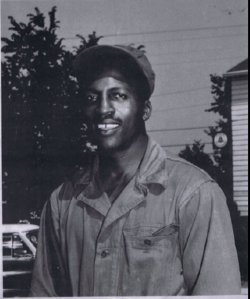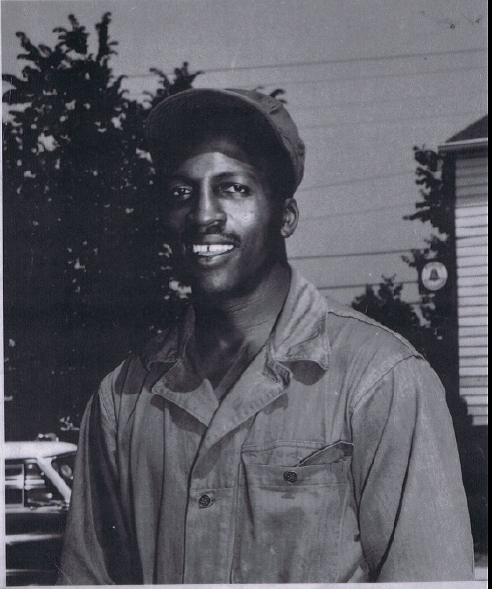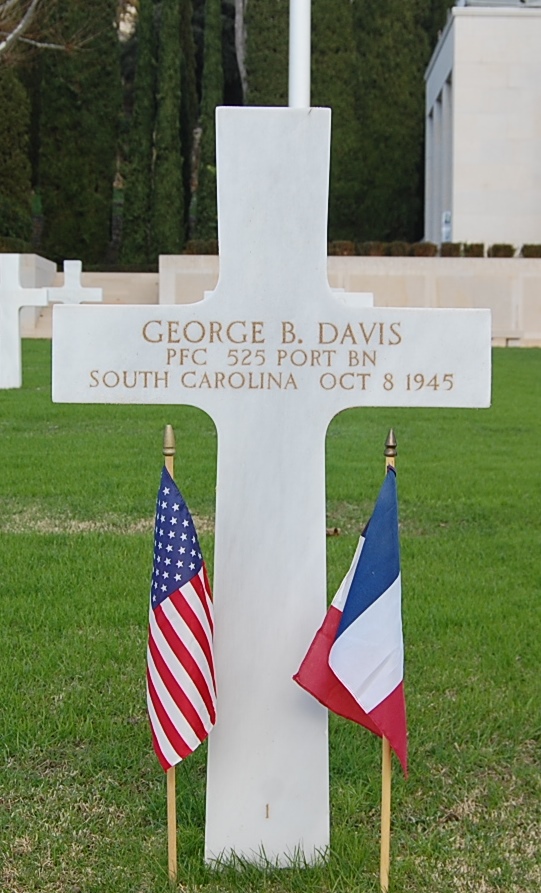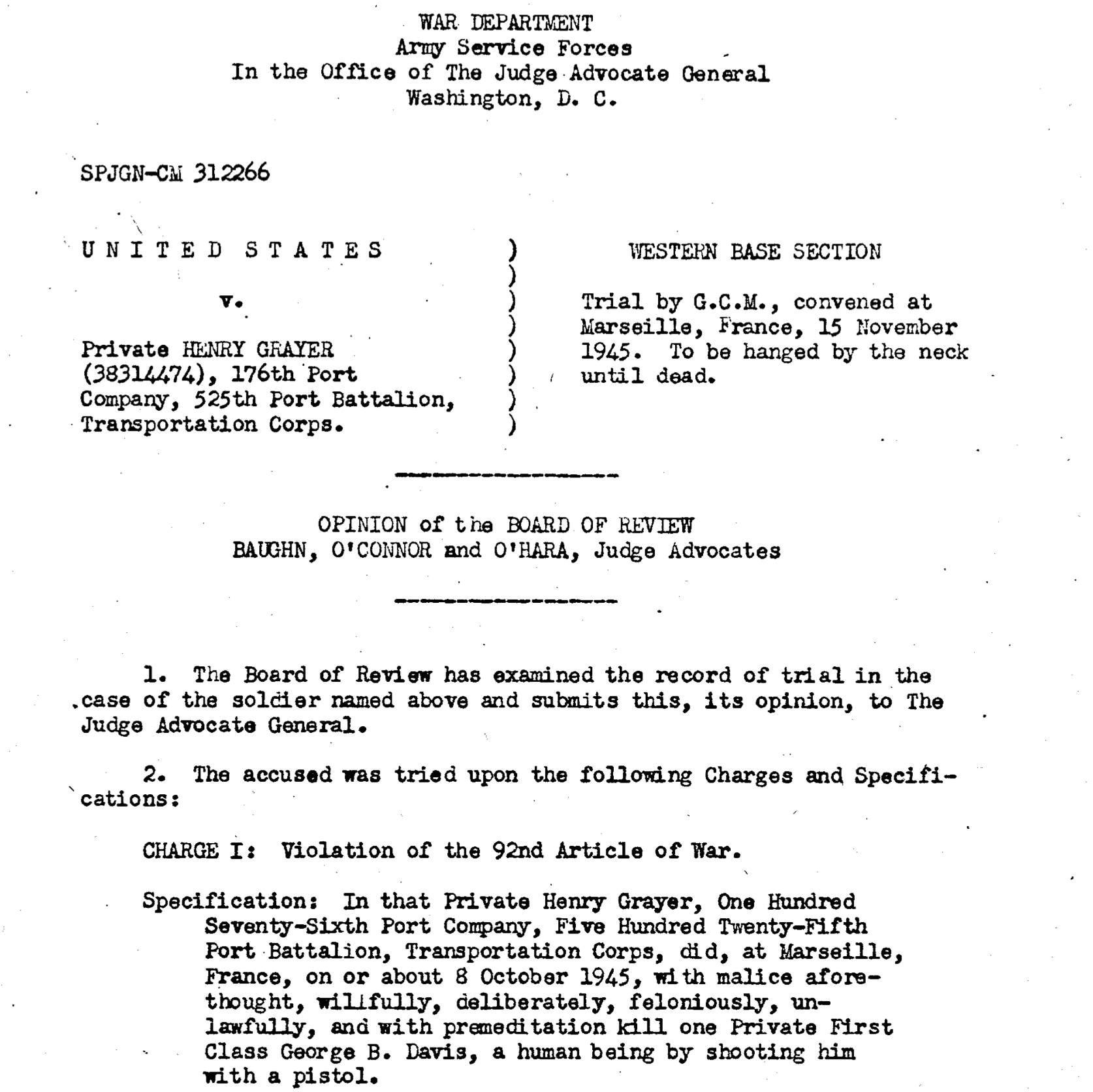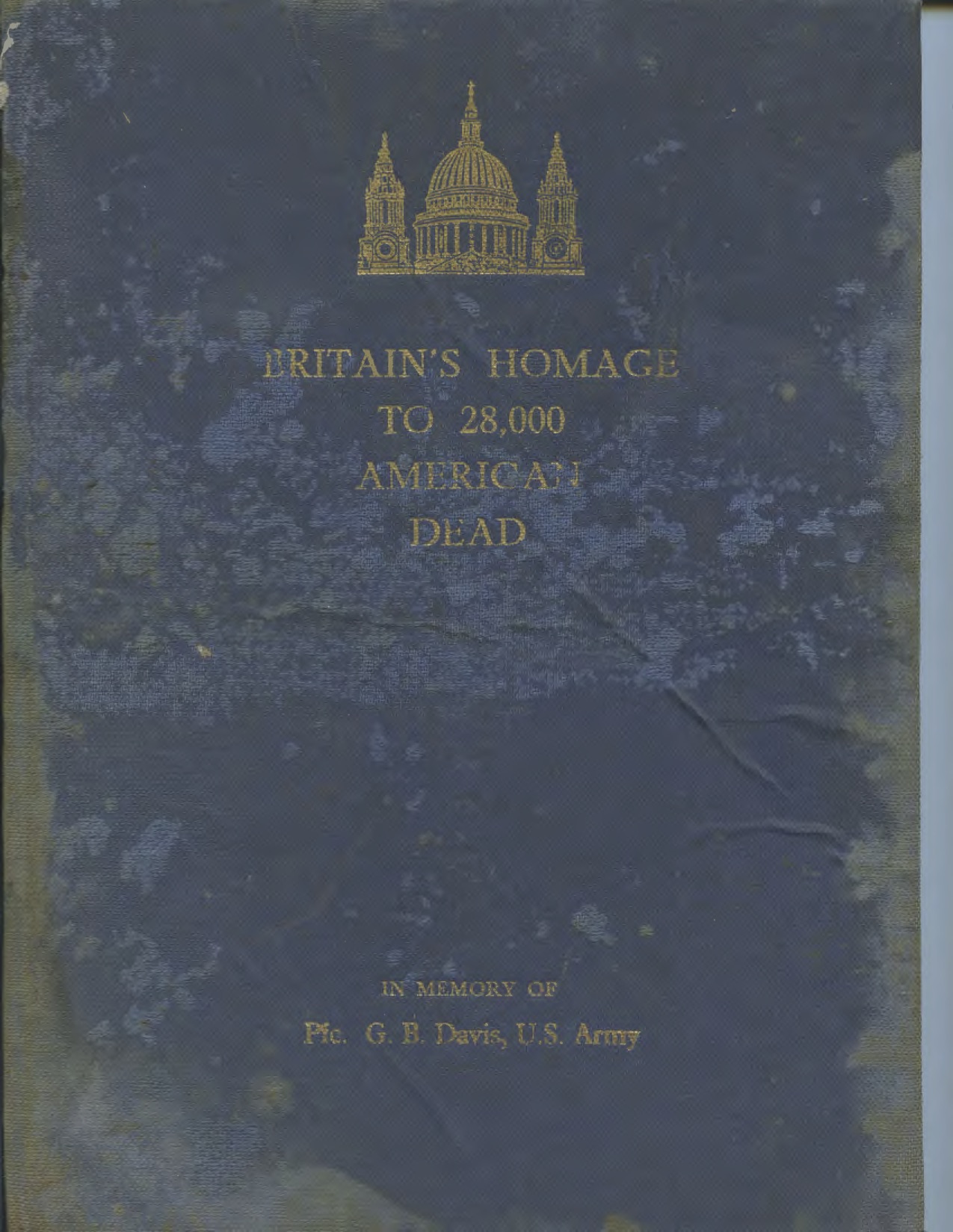George Burly Davis lived with his mother and two siblings on Glendalyn Street in Spartanburg, South Carolina. His father, John, passed away when Davis was only ten. Davis attended Cummings Street School, a school for African-American students. He was considered a high school graduate since he completed eleventh grade.
His older sister, Johnnie Mae, graduated two years before Davis and later moved to Brooklyn. His younger brother, Samuel, finished school two years after Davis and joined the U.S. Navy. Davis married Sennie Reid and worked as a truck driver for a wholesale house. In 1943, he was drafted into the U.S. Army.
The Davis family, living in Spartanburg, South Carolina in 1940
Military Experience
Davis completed boot camp at Fort Jackson in Columbia, South Carolina. Davis was then sent to Fort Clark, Texas. He trained as a stevedore and was assigned to the 525th Port Battalion. The 525th Port Battalion embarked from Newport News, Virginia, on February 28, 1944. Nine days later, Davis debarked in Oran, Algeria.
The 525th Port Battalion, an African-American unit, arrived in early March 1944 and was assigned to the 399th Port Battalion for further training. Davis, along with the other soldiers, attended 25 days of classes in the Principles of Stevedoring. A stevedore works on docks to load and unload cargo from ships in port. During this training period all units of the battalion constructed a recreation hall, mess halls, and latrines.
On July 9, 1944, the 525th Port Battalion completed its training. The battalion took over the operations of Mole Millerand, one of the many jetties, or piers, in the port of Oran, Algeria. Its mission was to unload and discharge materiel to combat units.
While in Oran, soldiers formed football and basketball leagues and held scrimmages. They also watched movies and attended concerts. However, Davis and the other soldiers of the 525th Port Battalion were required to continue training about safety regulations on the docks. The U.S. Army also instructed the men on how to conserve supplies and fuel for motor vehicles. Davis and the 525th Port Battalion shipped out of Oran on February 21, 1945, for Germany.
Upon arrival in Heilbronn, Germany, on March 17, 1945, the battalion was assigned to the Continental Advance Section, CONAD. It performed duties of loading and reloading trucks at a transfer point along with the 6th Port Transfer Company. Davis and the 525th Port Battalion drove approximately 20,000 miles a month delivering supplies to combat forces. The unit was also responsible for the security and supervision of two German Prisoner of War companies.
Even though Germany surrendered in May 1945, the unit continued to distribute supplies daily to Allied soldiers still in Europe. On September 5, the 525th Port Battalion moved to the Calas Staging Area on the southern coast of France where it began to process the redeployment of soldiers to the United States.
While awaiting his papers, George Burly Davis died of a gunshot wound to the chest on October 8, 1945. Records do not indicate the circumstances surrounding his death.
Davis completed boot camp at Fort Jackson in Columbia, South Carolina
In every action report, the commanders of the 525th Port Battalion described their soldiers as hard working and successful in achieving their goals each day. As a member of the 525th Port Battalion, George Burly Davis gave even more.
When notified of her husbands death, Sennie found it appropriate to permit the U.S. Army to bury Davis in France with other soldiers. Davis was first buried in the temporary American military cemetery in Luynes, just north of Marseilles. Davis now rests eternally at Rhone American Cemetery in Draguignan, France.
Elizabeth the Queen Mother, the Archbishop of Canterbury, and the Bishop of London attended a special service at St. Pauls Cathedral on July 4, 1951. General Dwight D. Eisenhower presented a Roll of Honour containing the names of 28,000 American servicemen who "gave their lives in military operations from the British Isles." This red leather bound book contains 473 pages of handwritten names listed alphabetically.
In January 1954, Daviss mother, Loraine, received a package from the London Times in which she found a blue leather bound book titled Britains Homage to 28,000 American Dead. At the bottom of the book, the British had embossed, In Memory of Pfc. G.B. Davis, U.S. Army. Also enclosed in the package was a letter asking Daviss mother to confirm that she had received the book. To this day, the Roll of Honour is located in a special alcove in St. Pauls Cathedral, where each day a page is turned in a special service to honor each soldier for their service during World War II.
While it is unclear why Lorraine Davis received this record, it served as a recognition of her sons service and sacrifice.
George Burly Davis lived with his mother and two siblings on Glendalyn Street in Spartanburg, South Carolina. His father, John, passed away when Davis was only ten. Davis attended Cummings Street School, a school for African-American students. He was considered a high school graduate since he completed eleventh grade.
His older sister, Johnnie Mae, graduated two years before Davis and later moved to Brooklyn. His younger brother, Samuel, finished school two years after Davis and joined the U.S. Navy. Davis married Sennie Reid and worked as a truck driver for a wholesale house. In 1943, he was drafted into the U.S. Army.
The Davis family, living in Spartanburg, South Carolina in 1940
Military Experience
Davis completed boot camp at Fort Jackson in Columbia, South Carolina. Davis was then sent to Fort Clark, Texas. He trained as a stevedore and was assigned to the 525th Port Battalion. The 525th Port Battalion embarked from Newport News, Virginia, on February 28, 1944. Nine days later, Davis debarked in Oran, Algeria.
The 525th Port Battalion, an African-American unit, arrived in early March 1944 and was assigned to the 399th Port Battalion for further training. Davis, along with the other soldiers, attended 25 days of classes in the Principles of Stevedoring. A stevedore works on docks to load and unload cargo from ships in port. During this training period all units of the battalion constructed a recreation hall, mess halls, and latrines.
On July 9, 1944, the 525th Port Battalion completed its training. The battalion took over the operations of Mole Millerand, one of the many jetties, or piers, in the port of Oran, Algeria. Its mission was to unload and discharge materiel to combat units.
While in Oran, soldiers formed football and basketball leagues and held scrimmages. They also watched movies and attended concerts. However, Davis and the other soldiers of the 525th Port Battalion were required to continue training about safety regulations on the docks. The U.S. Army also instructed the men on how to conserve supplies and fuel for motor vehicles. Davis and the 525th Port Battalion shipped out of Oran on February 21, 1945, for Germany.
Upon arrival in Heilbronn, Germany, on March 17, 1945, the battalion was assigned to the Continental Advance Section, CONAD. It performed duties of loading and reloading trucks at a transfer point along with the 6th Port Transfer Company. Davis and the 525th Port Battalion drove approximately 20,000 miles a month delivering supplies to combat forces. The unit was also responsible for the security and supervision of two German Prisoner of War companies.
Even though Germany surrendered in May 1945, the unit continued to distribute supplies daily to Allied soldiers still in Europe. On September 5, the 525th Port Battalion moved to the Calas Staging Area on the southern coast of France where it began to process the redeployment of soldiers to the United States.
While awaiting his papers, George Burly Davis died of a gunshot wound to the chest on October 8, 1945. Records do not indicate the circumstances surrounding his death.
Davis completed boot camp at Fort Jackson in Columbia, South Carolina
In every action report, the commanders of the 525th Port Battalion described their soldiers as hard working and successful in achieving their goals each day. As a member of the 525th Port Battalion, George Burly Davis gave even more.
When notified of her husbands death, Sennie found it appropriate to permit the U.S. Army to bury Davis in France with other soldiers. Davis was first buried in the temporary American military cemetery in Luynes, just north of Marseilles. Davis now rests eternally at Rhone American Cemetery in Draguignan, France.
Elizabeth the Queen Mother, the Archbishop of Canterbury, and the Bishop of London attended a special service at St. Pauls Cathedral on July 4, 1951. General Dwight D. Eisenhower presented a Roll of Honour containing the names of 28,000 American servicemen who "gave their lives in military operations from the British Isles." This red leather bound book contains 473 pages of handwritten names listed alphabetically.
In January 1954, Daviss mother, Loraine, received a package from the London Times in which she found a blue leather bound book titled Britains Homage to 28,000 American Dead. At the bottom of the book, the British had embossed, In Memory of Pfc. G.B. Davis, U.S. Army. Also enclosed in the package was a letter asking Daviss mother to confirm that she had received the book. To this day, the Roll of Honour is located in a special alcove in St. Pauls Cathedral, where each day a page is turned in a special service to honor each soldier for their service during World War II.
While it is unclear why Lorraine Davis received this record, it served as a recognition of her sons service and sacrifice.
Gravesite Details
Entered the service from South Carolina.
Sponsored by Ancestry
Advertisement
Advertisement
